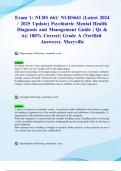ExamI1:INURSI661/INURS661I(LatestI2024
/I2025IUpdate)IPsychiatricIMentalIHealth
IDiagnosisIandIManagementIGuideI|IQsI&I
As|I100%ICorrect|IGradeIAI(VerifiedI
Answers)-IMaryville
Q:IHippocampusIfollowingIaItraumaticIevent
Answer:
ForIthoseIwhoIhaveIbeenIsignificantlyItraumatized,IitIisImuchIharderItoIprocessIanyInewIexpe
rienceIifIthereIareInotIenoughIcellsIinItheIhippocampus
DecreasedIfunctioningIofItheIhippocampusIisIcausedIbyIincreasedIlevelsIofIcortisolIcombinedI
withIotherIsubstances,IsuchIasIglutamate,IwhichIdamagesIdendritesIinItheIhippocampusIandIev
entuallyIcausesIcellIdeath.IGlucocorticoidsIsecretedIduringIaItraumaticIexperienceIshutIdownIt
heIhippocampusIandImakeIitIimpossibleIforImemoryItoIbeIadaptivelyIlinked.ITheseIhormonalI
changesIresultIinIbehavioralIdisinhibitionIandIanIinabilityItoIlearnIfromIexperience.
Q:IAmygdalaIfollowingIaItraumaticIevent
Answer:
2ItypesIofIreactionsItoItraumaticIevents:I1)IemotionalIunderImodulationIwithIintrusiveIsympto
msIleadingItoIhyperactivityIofItheImedialIprefrontalIcortexIandIinhibitionIofItheIamygdala,I2)I
hypoarousalIofItheIprefrontalIcortexIandIactivationIofItheIamygdala
WhenItheIamygdalaIisIoveractivatedIandIirritable,IkindlingIoccurs.IKindlingIrefersItoIlowering
IofItheIexcitabilityIthresholdIofIneurons,IrenderingItheIpersonIincreasinglyIlikelyItoIdevelopIce
rtainIsymptoms.
WithIrepeatedIstress,IkindlingIisIthoughtItoIsensitizeIlimbicIneurons,IsoItheIreactionsIareIsetIof
fIbyIstimuliIthatIwereIpreviouslyIsubthreshold
Q:IHypothalamusIfollowingIaItraumaticIevent
,Answer:
RegulatesIBP,IbodyItemperature,Isleep,Iappetite,IglucoseIlevels,IandItheIautonomicInervousIsy
stem.
DuringIstress,IaIcascadeIofIphysiologicalIresponsesIoccurs,IwithItheIlimbic-
hypothalamicIsystemImodulatingIandIcoordinatingItheIbiochemicalIactivityIofItheIautonomic,I
endocrine,IandIimmuneIsystems
Q:IThalamusIfollowingIaItraumaticIevent
Answer:
MediatesItheIinteractionIbetweenIattentionIandIarousalIandIisIthereforeIrelevantItoItheIphenom
enologyIofItrauma.
CanIresultIinIsignificantImemoryIproblems,IandItheIpersonImayIbeIunableItoIintegrateImemori
esIintoItheIpresentIandIpersonalImemoryIintoIidentity.ITheseImemoriesIareIisolatedIfromIcons
ciousnessIandIthoughtItoIunderlieItheIexperiencesIofIflashbacks,Inightmares,Iavoidances,IandId
issociation
Q:IAttunement
Answer:
TheIcapacityItoIreadIsignalsI(oftenInonverbal)IthatIindicateItheIneedIforIengagementIorIdiseng
agement
Q:IEgocentrism
Answer:
HavingIorIregardingItheIselfIorItheIindividualIasItheIcenterIofIallIthings
Piaget'sIStagesIofICognitiveIDevelopment:I2-6/7-year-oldsIareIthis
Someone'sIinabilityItoIunderstandIthatIanotherIperson'sIviewIorIopinionImayIbeIdifferentIthanI
theirIown
,Q:IMinimizing
Answer:
CognitiveIdistortionIconsistingIofIaItendencyItoIpresentIeventsItoIoneselfIorIothersIasIinsignifi
cantIorIunimportant
Q:INeuroplasticity
Answer:
RefersItoIareasIthatIareIresponsiveItoItheIenvironmentIandIthatIcanIchange.
TheIlowerIbrainIstructuresIsuchIasItheIbrainstemIareImoreIfixedIthanItheIhigherIbrainIfunction
sIofItheIcortex,IwhichIcontinueItoIdevelopIthroughoutIlife.ITheIcortexIisItheImostI"plastic"Iare
aIofItheIbrain
GrowthIandIreorganization
Q:INurturing
Answer:
CareIforIandIencourageItheIgrowthIorIdevelopmentIof
Q:IOverdeterminism
Answer:
RefersItoItheIideaIthatIaIproblemImostIoftenIhasImanyIdifferentIcauses.
TheIpatientImayInotIbeIableItoIprovideIaIfullIdescriptionIofItheseIcontributionsIandImostIlikel
yIisIunawareIofItheImultipleIreasonsIforItheIcurrentIsymptom.
Ex:IaIyoungIwomanIwithIbulimiaImayIhaveIfactorsIthatIcontributedItoItheIdevelopmentIofIher
Iproblem:IsexualIabuse,IfeelingsIofIdeprivationIandIneglect,IrecentIloss,IgeneticIpredisposition,
, IfearIofIweighIgain,IculturalIpressures,IoveremphasisIonIweightIinIherIfamily,IinabilityItoIself-
soothe,IhormonalIimbalance,Istress,IfriendIwhoIisIbulimic,Iabusive/alcoholicIfather,Idepressed/
unavailableImother,IfinancialIdifficulties
Q:IReframing
Answer:
AIstrategyIthatIpeopleIcanIuse,IeitherIonItheirIownIorIinItherapy,ItoIhelpIadjustItheirImindset.I
ItIoftenIinvolvesIfocusingIonImoreIpositiveIthoughts,IbutIitIcanIalsoIbeIcenteredIonIchangingI
excessivelyIhighIexpectationsItoIbeImoreIrealistic
AItherapeuticItechniqueIthatIassistsIindividualsIinIbroadeningIrestrictedIperspectives
Q:IResilience
Answer:
TheIabilityIofIanIindividual,Ifamily,IorIcommunityItoIcopeIwithIadversityIandItrauma,IandIada
ptItoIchallengesIthroughIindividualIphysicalIemotional,IandIspiritualIattributesIandIaccessItoIc
ulturalIandIsocialIresources
Q:ITheIBiomedical/AllopathicIModel
Answer:
AimIisItoIcure
SymptomsIareIoftenIthoughtItoIbeItheIcauseIofItheIpatient'sIproblemIandIpsychotropicImedicat
ionsIareIprescribedItoItargetIspecificIsymptomsIinIanIeffortItoIeliminateIorIreduceIsymptoms
Q:IHolisticImodel
Answer:




